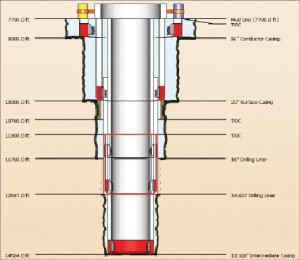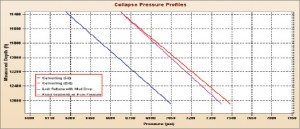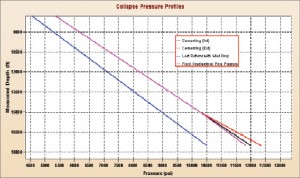Mono-diameter expandable drilling liner applications in deepwater – ready or not?
By Nitesh Kumar, Roy Marker, Rune Corneliussen, Erik G Kirkemo, Erik Rønneberg, Statoil

Claims can be found in technical literature for using mono-diameter expandable liners in deepwater applications. In a technical review of the existing mono-diameter expandable liner systems by various vendors, it is concluded that mono-diameter expandable liner can be considered for use as a drilling liner if certain prerequisites, as discussed in this article, are met.
Further, the technology can be used in brownfield development where no pore pressure surprises are expected. In any case, once drilling to target has been achieved, the liner must be covered by a conventional casing design. Proper risk evaluation before running in the hole is recommended, given the high costs associated with deepwater wells.
On the other hand, if the mono-diameter expandable liner has to be used for deepwater preplanning and casing design, substantial increases in strength will be required; otherwise it will not meet industry-standard casing design criteria. From a design perspective, one-time or multiple mono-diameter expandable liner extensions are the same. The key issue is meeting the collapse pressure requirements.
This article discusses technical aspects of mono-diameter expandable liner technology as currently available in different sizes from various vendors. The use, advantages and disadvantages of mono-diameter expandable liners in deepwater wells will be analyzed from a casing design perspective and with strength considerations.
THE CONCEPT
The mono-diameter expandable drilling liner, which gives a one-time option to extend the long string and liner sizes of 13 3/8 in. and 9 3/8 in., respectively. The goal is to provide an attractive solution to obtain several sections of the hole without compromising the completion diameter. The technology is aimed at providing flexibility on the number of sections drilled in a well, though it could be extended toward limited development work.
Some companies refer to this product as a second-generation system.
Stewart et al suggest that expandable solid tubulars can have mono-diameter expandable liners as a potential application. They define the maximum achievable expansion ratio ![]() as the engineering hoop strain at burst rupture pressure:
as the engineering hoop strain at burst rupture pressure:
Further, they considered three cases of expansion for the mandrels due to be pumped, pulled and pushed. Applying Klever equations of burst rupture pressure, they showed that the burst rupture pressure remains the same or is slightly lower after the first expansion. The increase in diameter and reduction in wall thickness is compensated by the strain hardening of the material during expansion.
Dupal et al have discussed the capability of expanding and sealing sequentially installed expandable casing strings, or “nested” expandable liners. They claim that using nested expandable systems facilitates the employment of smaller, more economical drilling vessels to drill deepwater wells. On AC 557 in the Gulf of Mexico, at a water depth of 7,790 ft, they used the nested approach to extend the setting depth for the 13 3/8-in. casing shoe. A 17 ½-in. hole was drilled, and a 13 3/8-in. expandable liner was run and expanded to an ID of 14.17 in.
Then, another 17 ½-in. hole was drilled using bi-center bit technology, and a 13 3/8-in. flush joint casing was run and cemented all the way to surface. By using the nested approach, the authors confirmed extending the 13 3/8-in. shoe by about 1,877 ft.
Campo et al have discussed the mono-diameter expandable liner concept from expansion efficiencies to potential savings. An analysis for a typical deepwater well in 5,000 ft of water, 29,000-ft TVD, drilled using the mono-diameter expandable drilling liner concept versus conventional principles, with 10 casing strings, suggested a well construction savings of 48%.
Roca et al have discussed five successful case histories of solid expandables. They claimed 100 successful installations worldwide have established solid expandable tubular technology as a viable drilling solution and process. Similarly, Kevin Waddell argued that single-diameter well technology should be incorporated in the well construction process in the original well design and not be limited to being contingency systems.
Ruggier et al added another use for solid expandable tubulars. For example, to close off perforations or to repair casing and shut off unwanted fluid entry, they claimed that use of this technology provides casing integrity without any significant loss of internal diameter.
This is far superior than conventional means, such as casing patches or packer straddles, which result in severe inside-diameter restrictions. The authors discussed a case history for two wells operated by RAG. York et al suggest that mono-diameter expandable liner could be run through salt while exiting the rubble zone.
They cite examples from the GOM, Caspian Sea and North Africa to validate the significance of using the larger-sized monobore liners. Like many other authors, Ruggier argued for using mono-diameter expandable liner concept early in the well planning process.

Aguiar et al have tried to understand the influence of the expansion of tubes on its mechanical strength through experimental tests and numerical analysis on parameters, such as diameter-to-thickness ratio and expansion rate on the collapse resistance of expandable tubes. The results showed that the non-expanded solid tubes presented collapse pressures significantly greater than those presented by expanded tubes. (Note that the maximum collapse resistance available for the best sample is 2,343 psi.)
The authors concluded that the tubulars have a considerable collapse pressure reduction with the increase in the expansion ratio. In general, a 10% expansion of pipe yielded an average of 50% reduction in collapse pressure.
DESIGN CRITERIA
The objective of this article is to examine the merits and limitations of liner technology for deepwater applications as per the casing design principles and requirements. There are technical reasons why the liner concept has not been used at the basis-of-design stage of deepwater wells, which several authors have recommended as described above.
Although there can be analysis on production load cases apart from drilling, the examination is limited to exploration wells, where the monobore expandable drilling liner is often assumed useful.
Further, technical analysis will be limited to the collapse strength. It is clear that collapse is the primary concern for expandable liners.
In order to show limitations of the monobore expandable drilling liner in deepwater, the design principles for collapse will be applied over two cases: large expandable liner and small expandable liner. Several scenarios were run for the two cases. The best examples showing the exposure of the monobore expandable drilling liner in these two cases are discussed below.
Case 1
Figure 1 shows wellbore schematic for the Case 1 well. Note that the 16-in. shoe was run to 11,760 ft, and a 14.9-in. hole was drilled below it to 12,647 ft. In this hole, the 14.827-in. OD mono-diameter expandable drilling liner was run. This well showed:
• The expandable was placed below the 16-in. drilling liner.
• The collapse safety factor’s sensitivity to reasonably sized changes in mud weights, in the order of 0.3 ppg; alternately mud drops approximately 350 ft.
Case 2
Figure 3 shows the wellbore schematic for the Case 2 well. The 13 5/8-in. shoe was run to 17,500 ft, and a 13 ¾-in. hole was drilled below it to 19,000 ft. In this hole, the 12.15-in. OD expandable drilling liner was run. The following could be observed from this example:
• The expandable was placed below the 13 5/8-in. intermediate casing.
• The collapse safety factor’s sensitivity to small changes in mud weights, in the order of 0.1 ppg; alternately mud drops approximately 50 ft.
• The advantage of using a smaller-diameter expandable with a slightly higher collapse rating compared with Case 1 was offset with the higher mud weights.
• The choice of gasified cements behind the expandable liner in deepwater environments at Case 2 depths can be useful.
• Collapse safety factor’s sensitivity to variations in cement density, which influences initial conditions on the expandable liner, are not significant.
FAILURE SCENARIO
From these two cases, it can be concluded that the failure for the monobore expandable drilling liner can happen in the following four cases:
• During cementing, the net load acting on the monobore expandable drilling liner can be significantly higher than the collapse rating of the expandable, which can result in its failure.
• During lost returns, mud loss of several feet is sufficient to damage the expandable drilling liner.
• Pressure ramps: Case 2 suggests that at deeper depths, if the length of the expandable drilling liner is significant, then the collapse differential pressure will be sufficient to damage the expandable. In deepwater, such ramps are fairly common; as such, risk mitigation and planning are essential.
• Emergency evacuation, riser disconnect: If the riser is disconnected from the well head, perhaps due to an upcoming storm, the differential pressure should not fall below the differential pressures suggested in the stress-check examples in the wellbore. The loss in hydrostatic pressure can happen because mud density due to the riser is replaced by water density.
CONDITIONS
Regardless of the technology’s limitations, it could be used and is being used for the following purposes:
• As a “drilling liner” for rubble zones, lost-circulations zones and depleted zones.
• To extend the shoe as discussed.
• To close off perforations or repair casing and shut off unwanted fluid entry.
In the above applications, the following conditions must be met:
• Hole is full with mud; so the differential pressure between the formation and the wellbore is never above the rated collapse pressure of the drilling liner.
• Knowledge of wellbore pressure and drilling mud density is a must.
• Drilling liner should be immediately covered by a proper liner.
• Knowledge of collapse of monobore expandable drilling liner is necessary. Service companies should certify that their liners have a minimum collapse pressure of the exact value.
• Risk analysis by the operator. If the liner fails in deepwater, the per-day cost can easily run USD$1 million per day. Is the team ready to take the associated risks?
CONCLUSIONS
• Monobore expandable liners can be used as a drilling liner, provided conditions mentioned in this article are met.
• Monobore expandable drilling liner extensions are limited by the collapse of the liner material.
• This technology should not be considered a drilling solution for deepwater, unless expandable liners are developed with equivalent burst and collapse ratings as currently used in the industry.
• The monobore expandable drilling liner is a good product for the future of deepwater drilling, but it has long way to go before engineers can use it with confidence in deepwater applications at the basis-of-design stage.
REFERENCES
1. R.B. Stewart, F. Marketz, W.C.M. Lohbeck, F.D. Fischer and W. Daves, “Expandable Wellbore
Tubulars” paper SPE 60766, presented at the 1999 SPE Technical Symposium held in Dhahran,
Saudi Arabia, October 1999.
2. Kenneth Dupal, Donald B. Campo, Colley J. Andrews, R. Lance Cook, Lev M. Ring, and Patrick L.
York, “Realization of the MonoDiameter Well: Evolution of a Game-Changing Technology” Paper
OTC 14312 Presented at the 2002 Offshore Technology Conference held in Houston, Texas U.S.A.,
6–9 May 2002.
3. Don Campo, Charlie Williams, Andrei Fillippov, Lane Cook, David Brisco, Bill Dean and Lev Ring,
“Monodiameter Drilling Liner – From Concept to Reality”, Paper SPE 79790, presented at the
drilling conference held in Amsterdam, The Netherlands, 19-21 February 2003.
4. Eduardo Perez Roca, Stacey Andrews & Doug Keel, “Addressing Common Drilling Challenges
Using Solid Expandable Tubular Technology, Paper SPE 80446, presented at the SPE Asia Pacific
Exhibition held in Jakarta, 15-17 April 2003.
5. Kevin Waddell, “Advances in Single Diameter Well Technology: The Next Step to Cost Effective
Optimization”, Paper SPE 90818, presented at the SPE ATCE in Houston, Texas USA, 26 – 29th
Spetember 2004.
6. Michael Ruggier, Scott Benzie, Rob Urselmann, Henrik Mosser and Roger van Noort, “Advances in
Expandable Tubing – A Case History” Paper SPE/IADC 67768 Presentated at the SPE/IADC
Drilling Conference held in Amsterdam, The Netherlands, 27 February–1 March 2001.
7. Pat York, Mike Sutherland, David Stephenson, and Lev Ring, “Solid Expandable Monobore
Openhole Liner Extends 13-5/8 in Casing Shoe without Hole Size Reduction” Paper OTC 19656
presented at the 2008 Offshore Technology Conference held in Houston, Texas, U.S.A., 5–8 May
2008.
8. Ana Carolina,Caldas Aguiar, “Strength Analysis of Expandable Tubular for Well Application” Paper
SPE 120193, presented at 2008 SPE ATCE held in Denver, Colorado, USA, 21 – 24, September
2008.
IADC/SPE 128175, “Mono Diameter Expandable Drilling Liner Applications in Deepwater Drilling,” was presented at the 2010 IADC/SPE Drilling Conference, 2-4 February, New Orleans, La.







